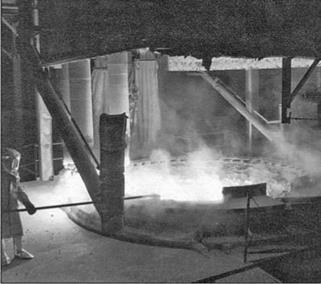Alumina-based abrasives are derived either from a traditional route of electrofusion, or more recently by chemical precipitation and/or sintering. Unlike SiC, alumina is available in a large range of grades because it allows substitution of other oxides in a solid solution, and defect content can be much more readily controlled. The following description of alumina-based abrasives is classified into electrofused alumina abrasives and chemically precipitated or sintered alumina abrasives.
3.3 ELECTROFUSED ALUMINA ABRASIVES
5.4.1 Manufacture
The most common raw material for electrofused alumina is bauxite, which, depending on source, contains 85 to 90% alumina, 2 to 5% TiO2, and up to 10% of iron oxide, silica, and basic oxides. The bauxite is fused in an electric-arc furnace at 2,600°C using a process demonstrated by Charles Jacobs in 1897 but first brought to commercial viability under the name “alundum” with the introduction of the Higgins furnace by Aldus C. Higgins of the Norton Company in 1904 (Figure 5.1) [Tymeson 1953].
A Higgins furnace consists of a thin metal shell on a heavy metal hearth. A wall of water running over the outside of the shell is sufficient to maintain the shell integrity. A bed of crushed and calcined bauxite (mixed with some coke and iron to remove impurities) is poured into the bottom of the furnace and a carbon starter rod is laid on it. Two or three large vertical carbon rods are then brought down to touch and a heavy current is applied. The starter rod is rapidly consumed but the heat generated melts the bauxite, which then becomes an electrolyte. Bauxite is added continually over the next several hours to build up the volume of melt to as much as 20 tonnes. Current flow is controlled by adjusting the height of the electrodes which are eventually consumed in the process.
Perhaps the most surprising feature of the process is the fact that a thin, water-cooled steel shell is sufficient to contain the process. This is indicative of the low thermal conductivity of
|
FIGURE 5.1 Higgins — type electric arc furnace for fusion processes of alumina and zirconia. (Courtesy of Saint-Gobain Abrasives. With permission.) |
alumina, a factor that is also significant for its grinding performance as will be described in later sections. The alumina forms a solid insulating crust next to the steel. After the fusion is complete, the furnace is either left to cool or, with more modern furnaces typical of those currently in use in the United States, the melt is poured onto a water-cooled steel hearth to better control microstructure.
Once cooled, the alumina is broken up and passed through a series of hammer, beater, crush, roller, and/or ball mills to reduce it to the required grain size. The type of crush process also controls the grain shape, producing either blocky or thin splintered grains. After milling, the product is sieved to the appropriate sizes down to about 40 pm (400#).

